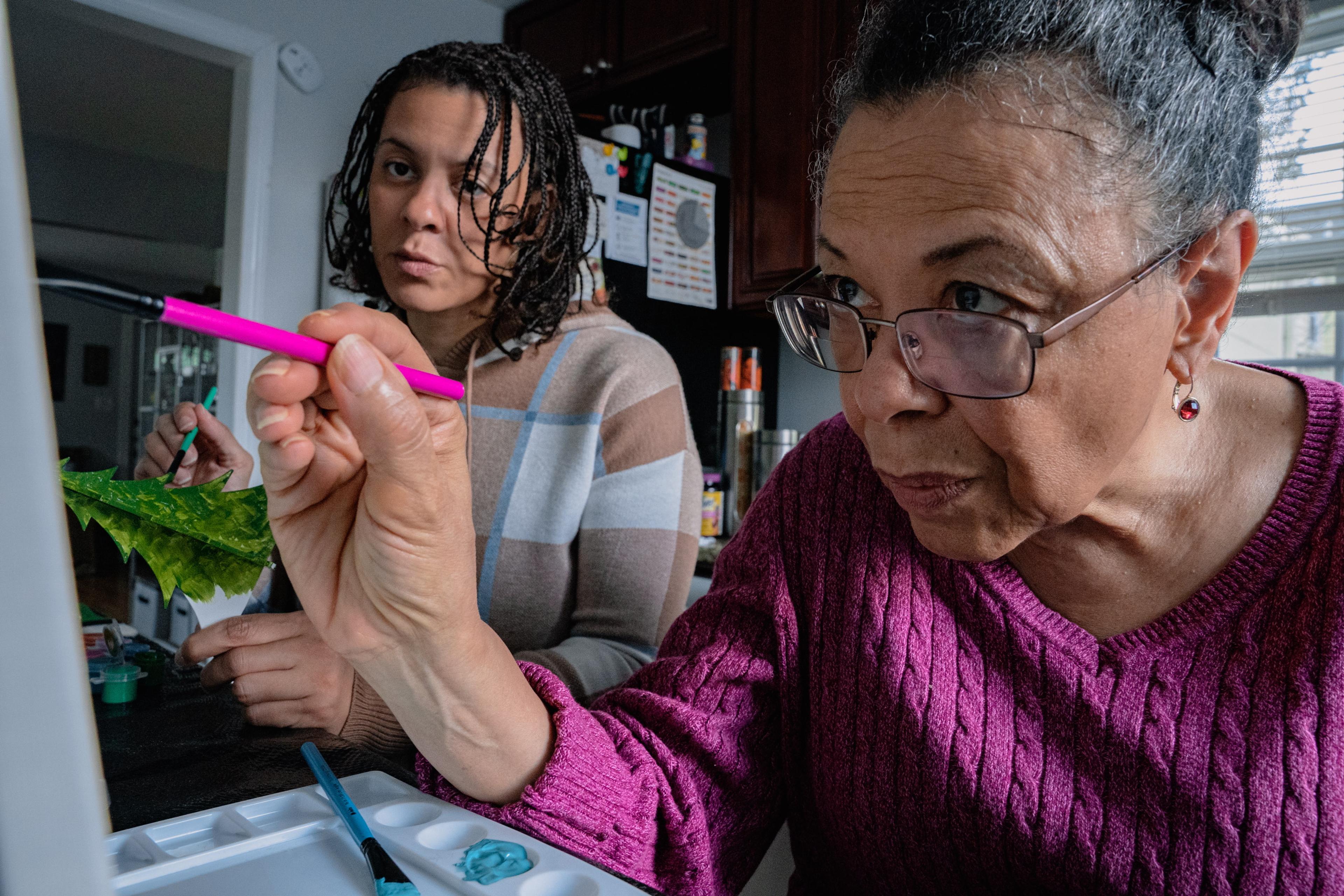During an activity designed for people with dementia, I had a conversation with an older woman who had been diagnosed with Alzheimer’s disease. We were sitting next to one another at a traditional Danish coffee table in a museum setting, and everything around us was furnished and decorated like a 1950s apartment, matching the period of her young adulthood. ‘Isn’t it strange,’ she said, ‘all the things that happened to me when I was young stand so vividly in my memory, but if you ask me what happened yesterday, I wouldn’t have the faintest idea.’ She then began telling me stories from her youth.
Increased longevity has rendered dementia tragically common: with prevalence rates increasing with age, it is estimated that about 10 per cent of people aged 65 and older currently live with Alzheimer’s disease, the most prevalent type of dementia. Alzheimer’s disease causes irreversible changes in the brain, and the damage begins in areas that are especially important to memory – notably, the hippocampus and surrounding areas in the medial temporal lobes (MTL). This is why one of the earliest complaints in Alzheimer’s disease concerns difficulties with remembering.
Autobiographical memory is especially compromised, even in the early stages of the disease. Autobiographical memory is the kind of memory that enables each of us to remember our own past, from a recent meeting at work to experiences we had when growing up. It is central to everyday functioning, including problem-solving, maintaining social relationships and having a sense of self-continuity over time. There is evidence that autobiographical memory deficits in Alzheimer’s disease are associated with identity impairments (not quite knowing who you are) and apathy. Although normal ageing also involves some reductions in the ability to remember the personal past, the deficits exhibited by individuals with Alzheimer’s disease are different and much more severe.
Yet, as illustrated by the woman I spoke with in the museum, not all periods of one’s life are equally hard to remember for someone with dementia. Evidence suggests that events and knowledge stemming from earlier in life are often more easily retrieved than more recent experiences. For example, a person with Alzheimer’s disease may be able to recount a memory of their wedding day, even with some details (eg, my bridal bouquet was lilies of the valley), while not being able to remember a family visit that happened yesterday. This possible sparing of distant memories in dementia has received substantial attention from researchers – and generated competing theoretical explanations.
One of the most prominent accounts derives from the ‘standard model of memory consolidation’, introduced by Larry Squire and Pablo Alvarez. According to this theory, memories are only temporarily dependent on the MTL structures in the brain. After a period of years, a gradual reorganisation takes place, and memories that were originally dependent on those structures are instead stored elsewhere in the brain, such as in the neocortex. This account provides a possible explanation of the relative sparing of distant memories in Alzheimer’s disease: since memories of the remote past have been consolidated elsewhere in the brain, they are less affected by damage to the MTL than are memories of recent events.
An alternative model, originally called the ‘multiple trace theory’, was introduced by Morris Moscovitch and Lynn Nadel. According to this framework, the expression of detailed, perceptually rich memories of specific events – which are known as episodic memories – always requires the involvement of MTL structures. Given the degeneration of these structures in Alzheimer’s disease, patients should show no relative sparing of episodic memories of long-ago events. In cases where patients nonetheless report memories for such events, this could reflect a transformation of the memory to a more abstract and gist-like (or semantic) form – for example, a frequently recalled memory of one’s wedding day with few, if any, concrete details.
To test theories such as these and better understand autobiographical memory in Alzheimer’s disease and other brain disorders, researchers have used structured interview procedures, in which participants are asked to produce memories from a series of specific periods in their life. One of these methods, the Autobiographical Memory Interview, asks for a number of memories and facts from each of three life periods – childhood, early adult life and recent adult life. Another method called the Autobiographical Interview asks for one memory from each of five time periods, and every memory is assessed for the amount of details generated.
Findings from these methods are mixed. Some studies show a progressively increasing frequency and elaboration of memories as they stretch further back into the past – consistent with predictions derived from the standard model of memory consolidation. Others show a flat distribution, consistent with predictions derived from the multiple trace view; it appears that events from any period of the lifetime are equally well (or poorly) remembered. How should these discrepancies be resolved?
Both of the two frameworks I have described centre on how memories are consolidated in the brain. A third and alternative approach takes a different starting point, looking at how autobiographical memories are distributed across the lifespan when people are asked to freely talk about their past.
Research with healthy adults has shown a distinct pattern: there is an increased frequency of memories recalled from late childhood to early adulthood, relative to the surrounding periods. If you chart the number of memories that people recall from different parts of the lifespan, the memories from late childhood and early adulthood form a ‘bump’ on the curve. This phenomenon, known as the reminiscence bump, was first identified by David C Rubin and colleagues in the 1980s. It has been replicated many times using different ways of sampling memories. The reminiscence bump has also been found in memories for semantic information, such as memories for public events or memorable books. Rather than pointing to purely biological mechanisms, most theories attribute the reminiscence bump to social and cultural factors, such as the formation of adult identity during early adulthood, or cultural norms attaching greater importance to this period in life, compared with other periods.
There is accumulating evidence that the reminiscence bump also appears in people with Alzheimer’s disease. The first study to find evidence of this asked older adults with Alzheimer’s disease and healthy older adults to talk about the events that had been important in their life in a 15-minute, open-ended narrative. After they had told their story, participants dated the events they had mentioned. Not surprisingly, participants with Alzheimer’s disease produced fewer memories overall from all life periods. However, they demonstrated a peak of memories in adolescence and early adulthood. A reminiscence bump has also been found when Alzheimer’s patients are asked to retrieve autobiographical memories in association to word cues, and during free conversations about the past. These findings may help to clarify the nature of memory loss in those affected. For people with this disease, it is likely that autobiographical memories are neither equally impaired across the lifespan, nor that they simply worsen progressively – going from one’s earliest years to the present – but that they instead follow the irregular shape of the reminiscence bump.
Methodological differences likely explain why standard structured interviews typically have not identified a reminiscence bump, since they probe only a few time periods, or ask for only one memory per time period, which may not be sufficiently sensitive to detect a bump. More open-ended methods enable the detection of a reminiscence bump by allowing for a more granular charting of memories across the lifespan.
However, a critical limitation of methods such as open-ended life stories is exactly that they allow participants to sample their own memories freely. How do we know that the tendency for memories to cluster in late childhood and early adulthood doesn’t just reflect a preference to talk about those ‘good old days’, rather than an actual inability to remember other times?
To address this concern and continue pursuing the hypothesis of a reminiscence bump in Alzheimer’s disease, my colleagues and I conducted a recent study on the topic. Our study used the Autobiographical Memory Interview, but we expanded the number of lifetime periods we would ask about from the standard three to seven. In this way, we ensured that participants tried to recall memories from periods across the whole lifespan, while the increased number of periods would allow for the detection of a reminiscence bump if there was one.
As expected, the distribution of memories for events produced by Alzheimer’s patients showed a dominance of autobiographical memories from ages six to 30, followed by a steep drop in memory referring to events that had occurred after age 30. These results provide corroborating evidence of a reminiscence bump in people with Alzheimer’s disease.
Although this finding raises a number of questions that call for more research, it also has important implications. It suggests that the relative sparing of older memories in dementia is not solely an effect of biological mechanisms related to memory consolidation in the brain. Like the reminiscence bump observed in healthy older adults, it likely also reflects social and cultural mechanisms, such as identity formation in young adulthood and culturally sanctioned age norms. These norms, known as cultural life scripts, include things such as knowing when in life a person is expected to get married, have their first child, or settle on a career, and they affect how we encode, rehearse and search for our memories.
Work with both older and younger adults has shown that such schematised expectations over-represent events in young adulthood, in line with the reminiscence bump. Recent research has also shown that cultural life scripts are largely preserved in older adults with mild to moderate Alzheimer’s disease, suggesting that they may indeed guide memory retrieval, and thus at least partly account for the bump.
The findings also have implications for therapeutic interventions that aim to revive autobiographical memory in people with dementia by using prompts such as music, photos, objects, movie clips and the like. Given the findings, it is important that such prompts are selected to make connections to the time covered by the reminiscence bump – roughly the time before the person turned 30. Choosing prompts from this salient period of life could maximise the likelihood that they will match memories that are still accessible.








